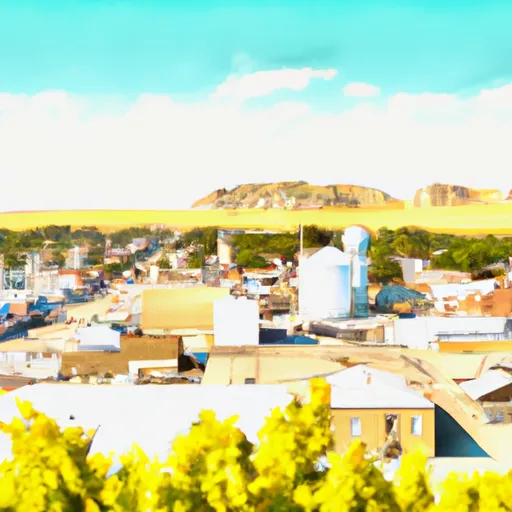-
 Snoflo Premium
Snoflo Premium
Get unlimited access to all our content
With no Ad interruptions! - Start Your Free Trial Login with existing account
Jeffrey-City
Eden Index
Climate
6.8
•
Recreation
0.3
•
Community
•
Safeguard
2.8/10

Jeffrey City is a small town located in Fremont County, Wyoming, with a population of around 58 people. It experiences a semi-arid climate, characterized by hot summers and cold winters. Summers are typically dry with temperatures reaching the mid-80s Fahrenheit, while winters are cold and snowy, with temperatures dropping well below freezing.
Hydrologically, the town is situated near several important water bodies. The nearby Sweetwater River provides irrigation water for agricultural activities in the region and supports diverse aquatic life. Additionally, the area is known for its uranium deposits, which have shaped the local hydrology and water quality over time.
Outdoor recreation opportunities in Jeffrey City and its surrounding areas are abundant. The breathtaking landscape offers opportunities for hiking, camping, and wildlife spotting. The nearby Jeffrey City Reservoir provides fishing and boating opportunities, attracting anglers and water enthusiasts. Additionally, the vast expanses of public lands surrounding the town allow for activities like hunting, off-roading, and photography. Visitors can explore the unique geological features of the region, such as the Wind River Canyon, which offers stunning views and opportunities for rock climbing. Overall, Jeffrey City offers a range of outdoor activities for nature enthusiasts to enjoy.
What is the Eden Index?
The Snoflo Eden Index serves as a comprehensive rating system for regions, evaluating their desirability through a holistic assessment of climate health, outdoor recreation opportunities, and natural disaster risk, acknowledging the profound impact of these factors on livability and well-being.
Climate Health Indicator (CHI): 6.8
Jeffrey-City receives approximately
277mm of rain per year,
with humidity levels near 68%
and air temperatures averaging around
6°C.
Jeffrey-City has a plant hardyness factor of
5, meaning
plants and agriculture in this region thrive during a short period during spring and early summer. Most
plants will die off during the colder winter months.
By considering the ideal temperature range, reliable water supplies, clean air, and stable seasonal rain or snowpacks, the Climate Health Indicator (CHI) underscores the significance of a healthy climate as the foundation for quality living.
A healthy climate is paramount for ensuring a high quality of life and livability in a region, fostering both physical well-being and environmental harmony. This can be characterized by ideal temperatures, reliable access to water supplies, clean air, and consistent seasonal rain or snowpacks.
Weather Forecast
Streamflow Conditions
North Platte
Area Rivers
North Platte
Snowpack Depths
North Platte
Reservoir Storage Capacity
North Platte
Groundwater Levels
Recreational Opportunity Index (ROI): 0.3
The Recreational Opportunity Index (ROI) recognizes the value of outdoor recreational options, such as parks, hiking trails, camping sites, and fishing spots, while acknowledging that climate plays a pivotal role in ensuring the comfort and consistency of these experiences.
Access to outdoor recreational opportunities, encompassing activities such as parks, hiking, camping, and fishing, is crucial for overall well-being, and the climate plays a pivotal role in enabling and enhancing these experiences, ensuring that individuals can engage in nature-based activities comfortably and consistently.
Camping Areas
| Campground | Campsites | Reservations | Toilets | Showers | Elevation |
|---|---|---|---|---|---|
| Cottonwood | 18 | 7,743 ft |
Nearby Ski Areas
Catastrophe Safeguard Index (CSI):
The Catastrophe Safeguard Index (CSI) recognizes that natural disaster risk, encompassing floods, fires, hurricanes, and tornadoes, can drastically affect safety and the overall appeal of an area.
The level of natural disaster risk in a region significantly affects safety and the overall livability, with climate change amplifying these risks by potentially increasing the frequency and intensity of events like floods, fires, hurricanes, and tornadoes, thereby posing substantial challenges to community resilience and well-being.
Community Resilience Indicator (CRI):
The Community Resilience Indicator (CRI) recognizes that education, healthcare, and socioeconomics are crucial to the well-being of a region. The CRI acknowledges the profound impact of these elements on residents' overall quality of life. By evaluating educational resources, healthcare accessibility, and economic inclusivity, the index captures the essential aspects that contribute to a thriving community, fostering resident satisfaction, equity, and social cohesion.

